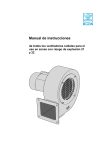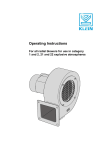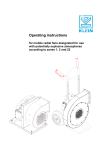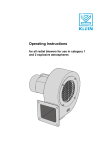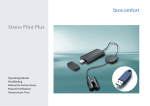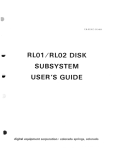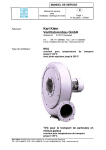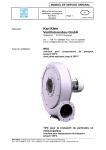Download Operating instructions - Karl Klein Ventilatorenbau GmbH
Transcript
Operating instructions for radial fans for use in potentially explosive atmospheres Operating instructions for radial fans for use in potentially explosive atmospheres Printed in Germany We reserve the right to make amendments to the details and illustrations listed as a result of further technical development. Any form of reproduction, translation or copying of all or part of this document requires the manufacturer's written approval. These operating instructions are not updated by an amendment service. Consult the manufacturer for details of the current status. Fa. KARL KLEIN Ventilatorenbau GmbH Waldstrasse 24 D-73773 Aichwald Tel.: 07 11 - 36 90 6-0 Fax.: 07 11 - 36 90 6-50 Internet: www.karl-klein.de E-mail: [email protected] Status: 04/2010 04/2010 KARL KLEIN Ventilatorenbau GmbH Page 1 Operating instructions for radial fans for use in potentially explosive atmospheres Contents 1 1.1 1.2 1.3 1.4 1.5 1.6 1.7 Preliminary remarks ........................................................................................................... 4 Manufacturer's information for the operator ......................................................................... 4 Responsibilities of the operators of fans used in potentially explosive atmospheres .......... 4 Warranty ............................................................................................................................... 5 Symbols used in these operating instructions ...................................................................... 6 Laws, regulations and specifications which relate to the product......................................... 7 National accident-prevention regulations and laws .............................................................. 7 Nameplates and information plates ...................................................................................... 8 2 2.1 2.2 Correct use .......................................................................................................................... 9 Limits of use and special features for correct operation ....................................................... 9 Incorrect use ......................................................................................................................... 9 3 3.1 3.2 3.2.1 3.2.2 3.2.3 3.3 Safety ................................................................................................................................... 10 Fundamental safety information ........................................................................................... 10 Emissions ............................................................................................................................. 11 Dust..................................................................................................................................... 11 Noise ................................................................................................................................... 11 Vibration .............................................................................................................................. 11 Heat protection ..................................................................................................................... 11 4 Transport and storage ........................................................................................................ 12 5 Description .......................................................................................................................... 13 6 6.1 6.2 6.3 6.4 Assembly / Installation ....................................................................................................... 14 General safety instructions for assembly and operation ...................................................... 14 Connection and installation .................................................................................................. 15 Assembly and installation requirements for potentially explosive atmospheres .................. 15 Fan mounting ........................................................................................................................ 16 7 7.1 7.2 7.3 Care, maintenance and repair instructions...................................................................... 17 Care and maintenance ......................................................................................................... 17 Checking the bearings .......................................................................................................... 17 Repair instructions and procedures ...................................................................................... 17 04/2010 KARL KLEIN Ventilatorenbau GmbH Page 2 Operating instructions for radial fans for use in potentially explosive atmospheres Follow the safety instructions Read all of the safety information contained in these operating instructions carefully. Before starting work, familiarise yourself with handling the fan. Once you have started work, it is too late. Never allow someone who is not familiar with this fan to operate it. Intention of these operating instructions These operating instructions accompany the fan. They also serve as installation instructions. These operating instructions are prepared by the manufacturer according to his knowledge and experience in the construction, manufacture and operation of the fan. The operator can add his own instructions (such as supervisory and reporting requirements and in-company maintenance and care schedules). Symbols used in these operating instructions The graphical illustrations and drawing represent the principle view of the fan. They are not to scale and do not reflect the proportions of any of the fans in the product range. The illustrations are intended for guidance only. The detailed dimensions and views are provided in the catalogue. Copyright The copyright to these instructions is the property of KARL KLEIN Ventilatorenbau GmbH. The copying of all or part of these instructions is prohibited without prior approval of KARL KLEIN Ventilatorenbau GmbH. 04/2010 KARL KLEIN Ventilatorenbau GmbH Page 3 Operating instructions for radial fans for use in potentially explosive atmospheres 1 Preliminary remarks 1 Preliminary remarks 1.1 Manufacturer's information for the operator As the operator you are responsible for: 1.2 • Correct use of the fan by trained, qualified staff as agreed by the manufacturer, • Adherence to the safety regulations, safety information and precautions for occupational safety and accident prevention, • The technical instruction of the operating personnel using the fan and their understanding of and familiarity with the operating instructions Responsibilities of the operators of fans used in potentially explosive atmospheres The German law on safe operation (Betriebssicherheitsverordnung, BetrSichV) and the 11th regulation of the German equipment safety law (Gerätesicherheitsgesetz, 11. GSG) contain precautions for operators of equipment for use in potentially explosive atmospheres. According to §3 of BetrSichV, the operator is obliged to carry out a risk assessment of the area in which the equipment is to be used. While doing so, the risks which may arise from using the equipment in connection with the working materials and the working environment must also be recognised and taken into consideration. According to §4 of BetrSichV, the operator must take the required precautions and select those operating materials which are suitable for the given conditions and working area and ensure the occupational safety and health protection of those concerned when used correctly. The KLEIN catalogue with detailed technical data and instructions for use is available with this in mind. When carrying out the risk assessment and selecting suitable equipment, the operator must comply with the 1999/92/EC/ Directive of the European Parliament and the Council for Operational Safety and the 94/9 EC Directive of 23rd March 1994 (also known as the ATEX Guidelines) as well as the relevant harmonised (EN) Standards such as EN 50014, Electrical Equipment for Potentially Explosive Atmospheres or EN 1127-1, Potentially Explosive Atmospheres. It is the sole responsibility of the operator to select the appropriate equipment (fan) for the expected area and expected application. 04/2010 KARL KLEIN Ventilatorenbau GmbH Page 4 Operating instructions for radial fans for use in potentially explosive atmospheres 1 Preliminary remarks 1.3 Warranty KARL KLEIN Ventilatorenbau GmbH provides warranty within the scope of its general sales and supply conditions. The warranty will become void if the method of installation and procedures, particularly in regard to correct use, are not followed. Unauthorised modification or alterations to the fan are not permitted. Only use genuine spare parts and accessories which are approved by KARL KLEIN Ventilatorenbau GmbH. Using other parts may result in impairment to operation. KARL KLEIN Ventilatorenbau GmbH will not accept liability for any damage resulting from using spare parts or accessories which have not been approved by the manufacturer. KARL KLEIN Ventilatorenbau GmbH will not accept liability for any damage resulting from the fan being repaired by the owner or from defective installation. 04/2010 KARL KLEIN Ventilatorenbau GmbH Page 5 Operating instructions for radial fans for use in potentially explosive atmospheres Preliminary remarks 1.4 Symbols used in these operating instructions The following symbols are used in these operating instructions. They indicate instructions on safety and damage prevention. Caution, power surge! Describes possible hazardous situations. Failure to follow such warning information can lead to death, serious injury or damage to property. Caution! Indicates a potentially hazardous situation. Failure to follow this can lead to injury or damage. Important! User tips for optimum equipment use and other useful information 04/2010 KARL KLEIN Ventilatorenbau GmbH Page 6 Operating instructions for radial fans for use in potentially explosive atmospheres 1 Preliminary remarks 1.5 Laws, regulations and specifications which relate to the product The fan has been designed and manufactured in accordance with the following guidelines and standards: 94/9/EC 98/37/EC 89/336/ECC 73/23/ECC Standards: Protection systems for potentially explosive atmospheres [Schutzsysteme für explosionsgefährdete Bereiche] Machinery guidelines [Maschinenrichtlinie] EMV Directive [EMV-Richtlinie] Low-voltage guidelines [Niederspannungsrichtlinie] EN ISO 12100-1/2 DIN EN 294 EN 1127-1 Safety of Machinery [Sicherheit von Maschinen] Safety distances [Sicherheitsabstände] Potentially explosive atmospheres [Explosionsfähige Atmosphären] EN 50014 Electrical equipment for potentially explosive atmospheres [Elektrische Betriebsmittel für explosionsgefährdete Bereiche] EN 5024 Special requirements for the design, testing and designation of Class II electrical equipment [Spezielle Anforderung an Konstruktion, Prüfung und Kennzeichnung elektrischer Betriebsmittel der Gerätegruppe II] EN 60079-10 Electrical equipment for potentially explosive gaseous atmospheres [Elektrische Betriebsmittel für gasexplosionsgefährdete Bereiche] DIN EN 61000-6-4 Electro-Magnetic Compatibility [Elektromagnetische Verträglichkeit] DIN EN 60204-1 Electical equipment for machinery [Elektrische Ausrüstung von Maschinen] DIN EN 60335-2-80 Safety of electrical equipment [Sicherheit elektrischer Geräte] 1.6 National accident-prevention regulations and laws UVV BGV stands for Accident-prevention regulations of the association of employer’s liability insurance associations UVV BGV 1 UVV BGV 4 UVV BGV 7w “General regulations” “Electrical systems and equipment” “Fans” When used outside Germany and the EEC, the local regulations of the country in which it is used apply. 04/2010 KARL KLEIN Ventilatorenbau GmbH Page 7 Operating instructions for radial fans for use in potentially explosive atmospheres 1 Preliminary remarks 1.7 Nameplates and information plates Important! The details on the nameplate are important for the correct use of equipment. All information plates must be kept clean and legible. Nameplates which have been lost or become illegible must be replaced immediately. The information on the nameplate indicates the required fan type and capacity. The information on the nameplate corresponds to the capacity requirements ordered. This can change. Important! The values given on the nameplate are crucial. Please find further permitted values on the order confirmation slip. 04/2010 KARL KLEIN Ventilatorenbau GmbH Page 8 Operating instructions for radial fans for use in potentially explosive atmospheres 2 Correct use 2 Correct use Important! The identification number of the fan is II 2 G T3 c (T4) T3 = to 200°C surface temperature T4 = to 135°C surface temperature This KLEIN fan has been designed and manufactured to satisfy the requirements for use with gaseous, non aggressive media. The fan can be used to discharge explosive gases in Zones 1 and 2 (in compliance with RL 94/9 EC and BetrSichV). Zone 1 means that the fan has been designed for use in areas where explosive atmospheres such as mixtures of flammable substances with air in gaseous or vapour form or as a mist are occasionally to be expected. Zone 2 means normal operation in areas where explosive atmospheres are not to be expected. However, if explosive atmospheres do occur, they must only occur very briefly. Correct use also includes observing and keeping to the specifications and the information contained in these operating instructions. 2.1 Limits of use and special features for correct operation Correct operation also includes the following: 2.2 • The discharge medium must not contain liquid contaminants. Use a filter if necessary (see the KLEIN list of accessories). • If discharging aggressive media, the material properties of the media must be appropriate for the level of corrosion protection of the fan. • The fan must only be used when installed in plants and machinery. • The temperature of the discharge media must not exceed 70 C. • The temperature of the environment must remain within the range -20°C to +40°C. • Only operate the fan with a suction-protection grid fitted. o Incorrect use Incorrect and dangerous use means in particular • discharge of explosive or flammable media in Zones “0” or all zones (20-22) for dusts, • discharge of abrasive media, • discharge without a suitable suction protection grid fitted, • operation without a motor-protection circuit breaker, • use in areas with dust and dust pollution in the environment. Dust deposits must be small enough for the glow-temperature not to be reached, • any other use deviating from correct use, thus causing a risk. 04/2010 KARL KLEIN Ventilatorenbau GmbH Page 9 Operating instructions for radial fans for use in potentially explosive atmospheres 3 Safety 3 Safety 3.1 Fundamental safety information KLEIN fans are designed and manufactured in accordance with the recognized technological rules and the occupational safety and accident prevention regulations on the safety of machinery. They correspond to the latest standard of technology. In spite of this, fans can present a hazard, in particular when they are subjected to • improper use or • incorrect use. Important! • The fan must only be used when it is in perfect working order and when the electrical system is undamaged. Use of faulty equipment involves a risk to life and limb. • Light materials which may easily be sucked into the fan, such as Styropor or rags, etc. must not be left around the suction area. Make sure there is sufficient space in front of the suction opening. • Pay attention to the air discharge direction and area. If the blade breaks, the broken pieces can cause secondary damage in the buildings to be kept cool. • Protective electrical equipment (e. g. motor-protection circuit breaker etc.) must meet the requirements for the machine in which the fans are to be fitted. • Personnel must be familiar with all measures in these operating instructions for the correct handling and specialist handling of this piece of equipment. 04/2010 KARL KLEIN Ventilatorenbau GmbH Page 10 Operating instructions for radial fans for use in potentially explosive atmospheres 3 Safety 3.2 Emissions 3.2.1 Dust Whether there are harmful emissions or not will depend on the medium being discharged. 3.2.2 Noise The noise level will depend on the method of installation, method of attachment, environmental conditions and operating point of the fan. With certain types of installation and application, the running noise of the fan may reach high levels. These may be between 60 and 110 dB (A). Details on the noise levels are provided in the KLEIN catalogue. If it is absolutely necessary to carry out certain activities in the vicinity of the fan, appropriate noise protection measures must be put in place by the operator as part of his responsibility in accordance with the German law for safe operation (BetrSichV) (ear defenders etc.). 3.2.3 Vibration The dynamic balance of KLEIN fans is of such a high quality that no hazardous vibrations occur. Unavoidable imbalance can be reduced by using vibration-damping mountings so that no transfer to other components is possible. 3.3 Heat protection In order to prevent possible overheating, the operator is at liberty to fit additional thermal contacts if necessary. 04/2010 KARL KLEIN Ventilatorenbau GmbH Page 11 Operating instructions for radial fans for use in potentially explosive atmospheres 4 Transport and storage 4 Transport and storage Important! When moving and installing fans weighing more than 25 kg, use a suitable lifting strap to lift the fan safely and install it so that is remains at equilibrium. Only use suitable lifting tackle for transport. Avoid tilting the fan. Important! Dispose of packaging materials in the proper manner. Do not burn them. Instructions on storage Fans should, if possible, only be stored in closed, dry rooms before transport. Storage in outside areas with roofing is only permissible for a short period of time. Protect the fan from harmful environmental conditions and from mechanical damage. 04/2010 KARL KLEIN Ventilatorenbau GmbH Page 12 Operating instructions for radial fans for use in potentially explosive atmospheres 5 Description 5 Description Standard model KLEIN fans are clockwise running radial fans with ball bearings and are designed for singleor three-phase phase A.C. power supply connection. Where it is required to fit the fan the other way round, the direction of running is “anticlockwise”. The medium concerned is drawn in axially and blown out radially in the required direction (see illustration). 1 _0 01 KL _ 3 00 Direction of flow of medium 04/2010 KARL KLEIN Ventilatorenbau GmbH Page 13 Operating instructions for radial fans for use in potentially explosive atmospheres 6 Assembly / Installation 6 Assembly / Installation 6.1 General safety instructions for assembly and operation Warning! Danger to life from power surge! Connecting the cable ends of the fan to the mains power supply involves the risk of a power surge if the supply has not been de-energised beforehand. Before working on current carrying components, always switch off the supply. • Electrical connection must only be carried out by appropriately trained and qualified electricians who know about the installation of equipment in potentially explosive atmospheres. • When assembling and installing equipment in potentially explosive atmospheres, only use spark-inhibiting tools. • Electricians are persons who are familiar with the setting-up, installation, putting into service and operation of electrical equipment and or machinery and are appropriately qualified. • Education or training according to the standards of safety engineering in the care and use of appropriate safety equipment and accident prevention training. • The installation depends on the requirements for the fan as well as the functional specifications at the site of installation (on the machine or on the equipment). 04/2010 KARL KLEIN Ventilatorenbau GmbH Page 14 Operating instructions for radial fans for use in potentially explosive atmospheres 6 Assembly / Installation 6.2 Connection and installation Important! The terminal assignment is described in the terminal box. The wiring diagram must be followed. Correct connection ensures trouble-free operation. Important! Install the connection cables in accordance with the requirements for use and relevant local regulations. 6.3 Assembly and installation requirements for potentially explosive atmospheres Other compulsory requirements Important! The fan must only be mounted at one point. Either use the discharge flange, fan foot, motor bracket or the intermediate suction flange. • If the fan is to be used open to the air, the environment must be free of objects that could be sucked into the fan. • Minimum distance between the cool-air cowling and the wall: 20 mm • The fuse must be appropriate for the current rating of the motor in accordance with the motor specification (nameplate). 04/2010 KARL KLEIN Ventilatorenbau GmbH Page 15 Operating instructions for radial fans for use in potentially explosive atmospheres 6 Assembly / Installation 6.4 Fan mounting Caution! Possible damage to equipment Double mounting must be avoided at all costs. This can lead to damage and broken fan components. Decouple structure-borne noise by using a canvass mounting. The fan must only be mounted at one point. Either use the discharge flange, fan foot, motor bracket or the intermediate suction flange. Mounting examples 01 01_ _KL 004 On the discharge flange On the motor bracket 005_KL01_01 On the intermediate suction flange for wall mounting 04/2010 KARL KLEIN Ventilatorenbau GmbH Page 16 Operating instructions for radial fans for use in potentially explosive atmospheres 7 Care, maintenance and repair instructions 7 Care, maintenance and repair instructions Important! The fan is maintenance free for the period of use for which it is intended. However, the operator is at liberty to introduce additional cleaning or maintenance intervals depending on the use of the fan and particular plant design. 7.1 7.2 Care and maintenance • If holes have been provided for condensation water and if the fan is installed in a place where condensation is expected and therefore condensation water inside the motor is also expected, any condensation water which has collected at the lowest point of the end housing must be released and the opening closed again. • Check for contamination of the blower wheel in order to prevent it from becoming unbalanced. Checking the bearings • 7.3 Check the bearings for smooth and unimpeded operation at regular intervals by checking for bearing noise. Repair instructions and procedures Do not repair defective, out-of-true or damaged fans yourself but send them to the manufacturer for repair. Only the manufacturer can be guaranteed to repair the fan properly and check it for imbalance. The fan must only be dismantled by qualified specialist personnel. Caution! Possible damage to equipment When dismantling the fan, if the balance-clamps (1) on the vanes of the blower wheel are displaced or removed, the blower wheel will be out or balance. 1 Never repair fans yourself. If the fan is not assembled correctly, there will be a risk of explosion when it is next used. 006_KL01_01 04/2010 KARL KLEIN Ventilatorenbau GmbH Page 17




















